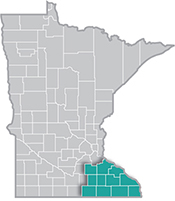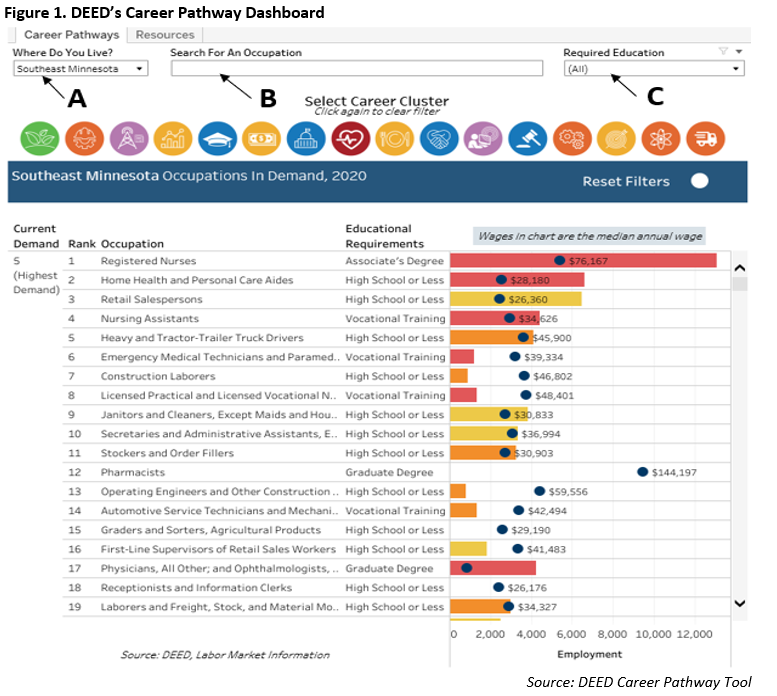 Southeast Minnesota is a health care and agricultural powerhouse. The region is home to the renowned Mayo Clinic and some of the world's most recognized food companies and brands.
Southeast Minnesota is a health care and agricultural powerhouse. The region is home to the renowned Mayo Clinic and some of the world's most recognized food companies and brands.
Advanced manufacturing is especially strong here, with machinery, chemicals, and electronics among the top products.
Want the freshest data delivered by email? Subscribe to our regional newsletters.
2/24/2021 9:00:00 AM
It's getting closer to that time of year where high school seniors are itching to graduate. Before you know it, caps and gowns will be flooding gymnasiums (if COVID-19 restrictions allow) and tassels will be moved from one side to the other before being flung into the air with unparalleled exuberance. Though they are excited to be done with high school, there are many seniors who still don't know what they want to do after high school, which is why starting to make post-graduation plans is a smart thing to do sooner rather than later. For some, going to a 2- or 4-year college is their route, while for others finding gainful employment immediately after graduation is the chosen path to success.
Luckily for these seniors, and even those in grades below them, the Minnesota Department of Employment and Economic Development has created a Career Pathways Tool which connects occupational data from DEED's Labor Market Information office with educational programming from the Minnesota State Career Wheel, displaying career fields, clusters and pathways. The primary goal of this tool is to help students understand how their educational path matches employment opportunities and is designed to help start career exploration with students, parents and counselors.
As Figure 1 shows, those using this data tool can focus in on labor market information for specific regions (A), search by specific occupations (B) and narrow it down to a singular educational level (C). After selections are made, the data automatically populates in the chart, including current demand rank, educational requirements, number of people employed in the occupation, and median annual wages.

For example, in Southeast Minnesota the highest in-demand occupation is Registered Nurses, and the minimum education required for this occupation is an associate's degree. By moving the mouse pointer over the red bar, one can see that there are 13,100 people employed as Registered Nurses (RNs) in the region and the blue dot indicates that the median annual wage is over $76,000. The chart also shows that 5 of the top 10 occupations in demand in the region are in health care, including Home Health and Personal Care Aides (ranked second), Nursing Assistants (ranked fourth), Emergency Medical Technicians and Paramedics (ranked sixth) and Licensed Practical and Licensed Vocational Nurses (ranked eighth). However, the chart also shows that there are significantly fewer people employed in each of these occupations than as RNs and the median wages are considerably lower.
In addition, on the "Resources" tab, users can find links to articles, blogs and other resources. DEED's Regional Analysis and Outreach team also provides a very valuable and useful Path to Career Success document that provides a wide variety of information to help individuals determine which workforce path is right for them. This document contains information on the number of jobs by educational attainment, which shows that almost 60% of the regional jobs require just a high school diploma while just 18% require a bachelor's degree or higher. This document also provides important information on annual costs of college based on institution type (i.e. state universities vs private non-profit universities), cost of living requirements, hourly wage ranges broken down by education (median hourly wages for jobs requiring an associate's degree sit at $36.62 whereas the median wage for those that require a high school diploma or less rest at $15.91) and regional in-demand occupations by education level.
Life after high school can be both challenging and rewarding, and there is an element of uncertainty that comes with having to make career decisions. The bottom line is that postsecondary education and career choices will ultimately have a profound impact on one's entire life, so it is important to make well-informed decisions early on. While it is unlikely that the first job out of high school or college will end up being the occupation one retires from, knowledge of the local labor market can help one make the best decisions at any point in their career, not just immediately after graduation.
Contact Mark Schultz.